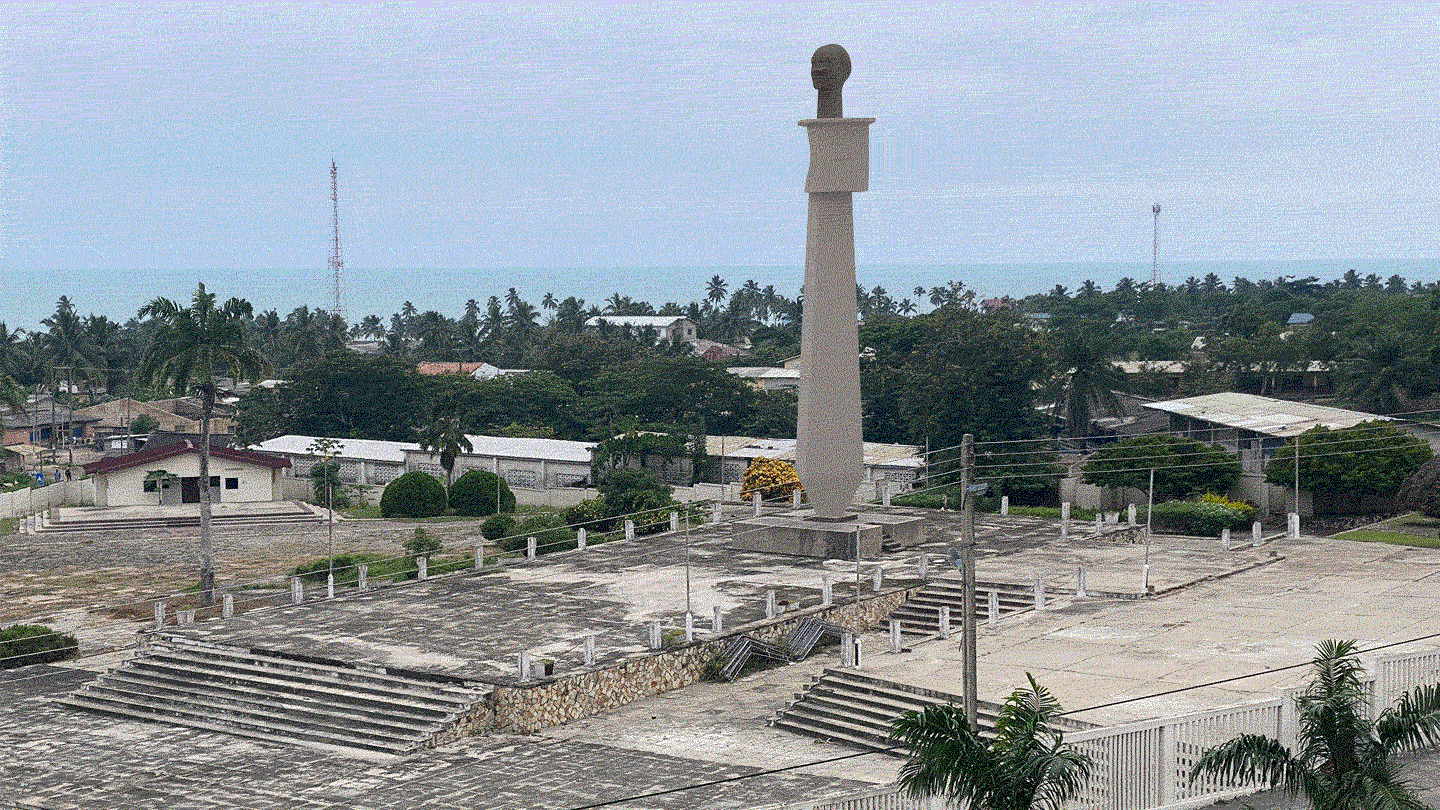35th Ljubljana Biennale of Graphic Arts
September 15, 2023–January 14, 2024
Pod turnom 3
SI- 1000 Ljubljana
Slovenia
The 35th Ljubljana Biennale of Graphic Arts entitled From the void came gifts of the cosmos will open on September 15 with a programme of events—guided tours, artist talks, performances and concerts—that will extend throughout the following weekend.
The Artistic Director of the Biennale, Ibrahim Mahama and the curatorial team (Exit Frame Collective, Alicia Knock, Selom Koffi Kudjie, Inga Lāce, Beya Othmani and Patrick Nii Okanta Ankrah) have invited artists and collectives from Africa, Europe and beyond, working in printmaking, film, installation and performance, to present new works created specifically for the Biennale alongside existing works. Printmaking works from the Biennale archive will also be exhibited.
Participants
Anita Afonu, Sadik Kwaish Alfraji, Yasmina Benabderrahmane, Assadour Bezdikian, Max Cegielski and Janek Simon, Virginia Chihota, Galle Winston Kofi Dawson, Nolan Oswald Dennis, Nabil Djedouani, DNLM (Danilo Milovanović), Jihan El Tahri, El Warcha in dialogue with PLAC (Participatory Ljubljana Autonomous Zone), Beti Frim and Ines Sekač, Helga Griffiths, Christian Guerematchi, Eric Gyamfi, Sonia Kacem, Mohammad Omar Khalil in dialogue with Abed Al Kadiri, Soghra Khurasani, Kolektiv Krater / Krater Collective, Kvadratni meter / Square Meter, Lalitha Lajmi, Malle Leis, Silvi Liiva, Kagiso Patrick Mautloa, Raul Meel, Amina Menia, Yussif Musah, Medhat Nasr Ali, Ilona Németh, noks collective, Nonument Group, NPR., Henry Obeng, Temitayo Ogunbiyi, Thierry Oussou, Krishna Reddy, Tjaša Rener, Martyna Rzepecka, Duba Sambolec, Jaanus Samma, School of Mutants (Hamedine Kane, Stéphane Verlet-Bottéro), Mori Sikora, Aldona Skirutyte, Sanaz Sohrabi, Tejswini Narayan Sonawane, Selasi Awusi Sosu, Sreda v sredo (SVS), Tracy Naa Koshie Thompson, Marje Üksine, Tõnis Vint, Ala Younis, Lara Žagar, Manca Žitnik.
The 35th Ljubljana Biennale of Graphic Arts explores the ecosystem of connections, solidarities and histories of resistance that emerge from the once close relations between post-independence Ghana and the former Yugoslavia. It looks at the emancipatory vision of Ghana’s pan-African theorist and first president Kwame Nkrumah, which gave rise to the intellectual, cultural, scientific and economic infrastructure that gave shape to Ghana’s first republic. Nkrumah pursued his vision by working with architects, designers, engineers and urban planners, who were active in countries like Ghana and Yugoslavia that were part of the Non-Aligned Movement. From the void came gifts of the cosmos looks to the connections between contemporary art and printmaking in the fields of architecture, design, agriculture and botany, and reflects on the proliferation of visual culture as a way of creating spaces of potentiality, portals between spaces that transcend borders.
The Biennale is conceived as a void and a space of potential that offers the possibility of transforming the void into gifts of the cosmos. In this context, the void suffices as an egalitarian framework from which multiplicities emerge, while functioning as a site of artistic indeterminacy in the spirit of inclusion.
Can the void created by past (political) failures serve as the soil for nurturing different relationships based on solidarity, friendship and intimacy? Artistic Director Ibrahim Mahama sees the upcoming Biennale as an opportunity to revive past connections and strengthen transnational alliances.
Focusing on the built environment and its intertwining with the modern history of anti-colonial and anti-imperialist struggle, nationalism and internationalism, the Biennale presents newly commissioned site-specific works that engage with this complex legacy.
Amina Menia’s Extensions of Struggle (2023) reflects on the spontaneous urban formations that have emerged in the Algerian capital. In a site-specific installation and a series of lithographs, the artist addresses urban material environments and the ways in which they are re-appropriated, reshaped and occupied through human or non-human interventions. The informal plans of urban spaces are treated as archival material thereby activating their historical materiality and poetic potential.
Artists Janek Simon and Max Cegielski travelled to Ghana to explore the traces of the work by Polish sculptor Alina Ślesińska, who created a monument to Ghana’s first president for the Kwame Nkrumah Ideological Institute in Winneba in the 1960s. The duo reflect on the importance of past friendships and the potential for transnational solidarity today.
As part of their project STONE EXPEDITION, NPR. ventures up Triglav, Slovenia’s highest peak, with a lithographic plate of limestone, to return with an engraving of the collective’s manifesto. The group explores team bonding as a process and a product of artmaking, and examines retroactively the transformation of the activity on the artists.
In the light installation In the end we decided not to give up, noks collective refer to the idea of foraging ideas through movements in a public, commonly used space that often retains an untold memory of the past. The project is complemented by a concert at the opening of the 35th Ljubljana Biennale of Graphic Arts.
From the void came gifts of the cosmos populates various locations in the city. In addition to the two locations of the International Centre for Graphic Arts in Tivoli Park (MGLC Tivoli Mansion and MGLC Švicarija) and Cukrarna, a former sugar factory, the Biennale unfolds beyond the gallery space. The Biennale’s venues include a former people’s kitchen, an abandoned boiler house and a temporary production space created from an abandoned crater-like construction site near the centre of Ljubljana.
The Biennale is accompanied by an intense conference programme from November 16 to 18 and an extensive Biennale Reader. The publication aims to critically unpack, while coming to terms with, the complexities of the emancipatory undertone of the Biennale’s title From the void came gifts of the cosmos. The book will consist of texts and other experimental contributions from a diverse group of authors including curators, architecture historians, critics, artists and theorists. The Reader is edited by Kwasi Ohene-Ayeh, Kelvin Haizel, Patrick Nii Okanta Ankrah and Selom Koffi Kudjie.
The Ljubljana Biennale of Graphic Arts traditionally presents the solo exhibition by the Grand Prize recipient of the previous edition. In 2021, the Grand Prize of the Ljubljana Biennale of Graphic Arts was awarded to JP Raether for Protekto.x.x 5.5.5.1 Precipitation, which was undersigned by Protektorama, one of Raether’s constructed identities. However, this year’s Transformella: Cinis’ Forking [4.4.6.10.1]—Die Schützlinginnen and Neverlife in Symbolic Terrain is neither a “solo” nor an “exhibition”, but a shrine to a psycho-real ritual of so-called “Ikeality” in local shops, where household goods and family models are mass-reproduced.



